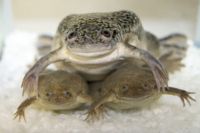
An international research consortium led by MCB scientists in the Harland and Rokhsar Labs, along with researchers at the University of Tokyo, "reports a striking pattern of genome duplication in the African clawed frog Xenopus laevis. The team showed that the frog’s genome arose through interspecific hybridizations of two now-extinct species between 15 and 20 million years ago."
Image: The genome of the African clawed frog Xenopus laevis (top) is roughly double that of the related western clawed frog X. tropicalis (bottom). Photo by Atsushi Suzuki, Hiroshima University.